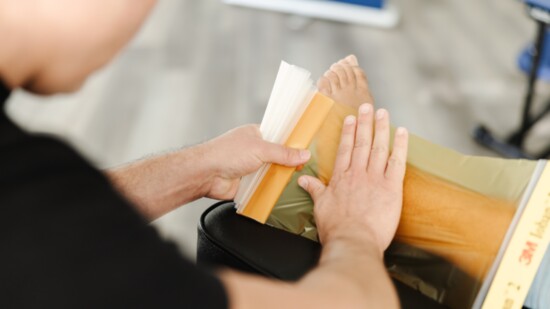With more than 15 years of experience in the medical field and dealing with injuries himself, Tom Thomas has seen firsthand the challenges people face in finding effective treatments for pain.
That was until friend and colleague Greg Papageorge, owner of New York Cryogen introduced him to ground-breaking technology that he had invented after dealing with extensive spine surgeries and recovery himself.
"He had basically tried everything, and nothing was working, so he was trying different cold therapy methods, and the light bulb went off, and he created high-pressure cryotherapy," Tom says.
Tom worked with Greg to bring a device to deliver the therapy to Arkansas at their business ARTX Cryogen, where he and his wife, Stephany, are now the exclusive providers of high-pressure cryotherapy in the state.
Since the therapy's inception, it has grown to be used in centers around the U.S., has been used in more than 10,000 treatments and has been approved by the American Medical Association.
So what makes this different from something like an ice bath or the cryotherapy chambers one may be more familiar with?
"Unlike traditional cryotherapy methods, which rely on surface-level cooling or whole body submersion, High-pressure cryotherapy targets specific areas of pain for deeper tissue penetration," Tom says.
According to observations and a clinical trial, this is effective at treating pain because it operates on the principle of rapid and controlled reduction of tissue inflammation, which is a primary contributor to pain and various musculoskeletal conditions.
High-pressure cryotherapy targets deeper tissue penetration by utilizing optimized skin surface temperatures. This is believed to accelerate the healing process and reduce acute and chronic pain.
Stephany and Tom start the therapy in the area by placing a protective sheathing material to help prevent the cold from making direct contact with the skin and avoid any irritation. Then, they target the area with liquid carbon dioxide (CO2) from a tank with the Hercules device that regulates the pressure and velocity of the CO2. Throughout the therapy, they also use a thermal monitoring device to measure the temperature of the area and make sure it reaches the optimal skin temperature, which is between 35 and 43 degrees, as this temperature has been identified as sufficiently cold enough to reduce inflammation and pain without inducing side effects. By constantly checking the temperature with a thermal monitor, they keep their clients safe.
"Safety is paramount for us,” Tom says. "What we've found is that the treatment protocol, which targets the area of concern, is designed to extend the anti-inflammatory effects by maintaining a sustained application of cryotherapy once the desired skin temperature is achieved."
It is also recommended that clients consult their doctors before starting high-pressure cryotherapy as there are some contraindications to cold therapy for those with certain conditions, Tom says.
Clinical trials have shown that people typically achieve optimal results after the third to fourth treatment. The frequency depends on the area being treated, the type of injury as in whether it is acute or chronic and the severity of the condition. Close proximity between sessions increases the likelihood of effectively eliminating and providing lasting relief, Tom says.
The results speak for themselves. Tom and Stephany have had a wide range of people at ARTX Cryogen, from athletes recovering from sprains and strains to elderly individuals seeking relief from chronic pain.
"An elderly lady with knee pain was able to resume normal activities after treatment," Tom says, "She said, 'Oh my gosh, I was able to wear my stilettos and high heels again.'"
Stephany and Tom have also used the therapy for their own weight-lifting injuries.
"We did two treatments, and I was back in the gym in a couple of days," Stephany said.
She also added that people who are going through physical therapy or doing things like yoga to help with pain and mobility should continue these activities along with high-pressure cryotherapy.
The couple remains committed to pushing the boundaries of what's possible in the world of cryotherapy. There is a new version of the device set to be released soon, and the couple often goes to New York to continue training with the inventor himself, Greg.
"We're constantly exploring new ways to improve the technology and expand its reach," Tom says. "Our goal is to make high-pressure cryotherapy accessible to as many people as possible."
They’re currently working to get insurance to cover the therapy, which Tom says will happen soon. They also hope to expand their business.
To book an appointment at ARTX Cryogen and for cost information, call 501-516-3128 or visit artxcryogen.com.
Tom Thomas is the CEO of ARTX Cryogen. With a background in medical devices and biotechnology, Tom brings extensive industry knowledge and a passion for innovation to Arkansas. He previously worked and held leadership roles at the International Stem Cell Medical Center, as well as Medtronic, NuVasive, and K2 Medical, in spine surgery, where he worked closely with orthopedic spine and neurosurgeons at renowned medical institutions, such as Mayo Clinic, New York University, Rush Hospital in Chicago, Hospital for Special Surgery in New York City, and Barrows Neurological Institute in Phoenix.
Stephany Thomas is the COO at ARTX Cryogen, driving a customer-first approach and operational excellence. With a background in retail, real estate, legal and more, she excels in client relations and strategic planning. She is also working toward certifications in nutrition and personal training. Stephany is dedicated to fostering a people-first culture and delivering top-notch standards, which makes her instrumental in its success and growth.
"Unlike traditional cryotherapy methods, which rely on surface-level cooling or whole body submersion, High-pressure cryotherapy targets specific areas of pain for deeper tissue penetration."
